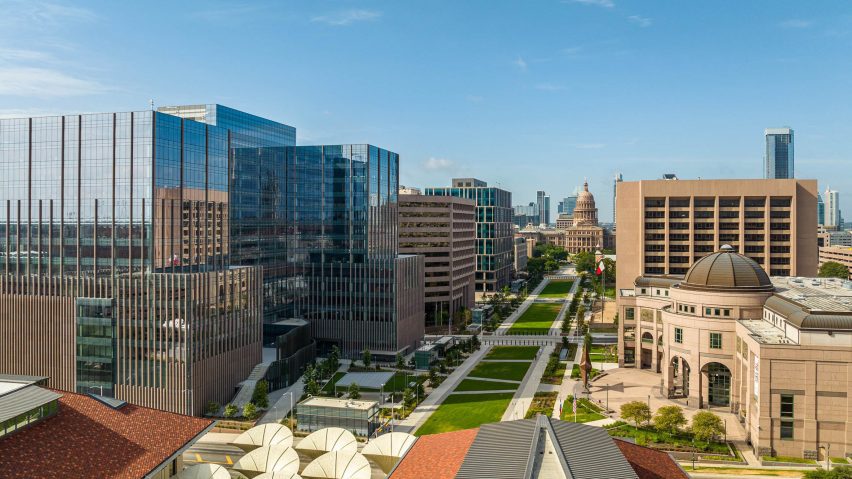
Page Southerland Page integrates "past and future" at Texas Capitol Complex
US studio Page Southerland Page has worked to "cultivate a stronger sense of community" with the urban design surrounding the Texas State Capitol that integrates historical landmarks in Austin.
The Texas Capitol Complex – designed for the Texas Facilities Commission – spans approximately 150 acres across 40 city blocks around the Texas State Capitol.
Page Southerland Page led the planning and urban design – guiding the full team that included HKS, Kirksey, Jacobs, Sasaki, and Coleman Assoc. – for the three-phase master plan, which was outlined in 2016.
"Our design inspiration draws from Austin's dynamic heritage and eclectic culture, striving to seamlessly blend the city's rich past with its promising future," Ryan Losch, lead urban designer and principal at Page Southerland Page, told Dezeen.
"We hope this project will enhance urban spaces in the city, contributing to the State of Texas' and Austin's unique, vibrant identity."
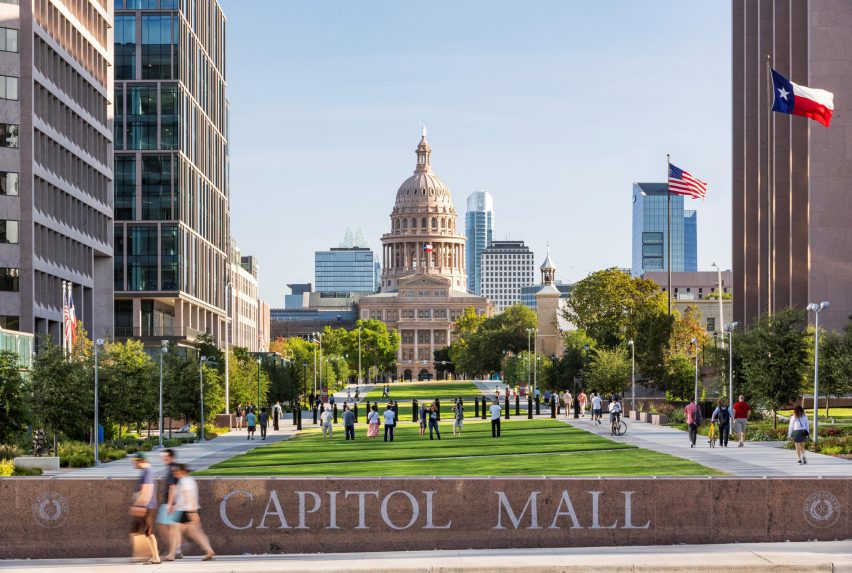
Phase 1 – which is estimated as a $600 million investment – opened in 2022.
It includes two new high-rise office buildings that measure over one million square feet (92,903 square metres), a central utility plant for efficient cooling and a five-storey, below-grade structure with over 3,000 square feet (280 square metres) of parking space.
Headquartered in Dallas, HKS served as the architect of record for the George HW Bush Building, which rises 14 storeys in blocks of glass with graduating bands of vertical sunshades as it sits on the northeast terminus of the Capitol Mall.
Based in Houston, Kirksey was the architect of record Barbara Jordan Building, a 12-storey rectangular building with a pattern of randomized facade dividers over horizontal bands of glass, located halfway down the public green.
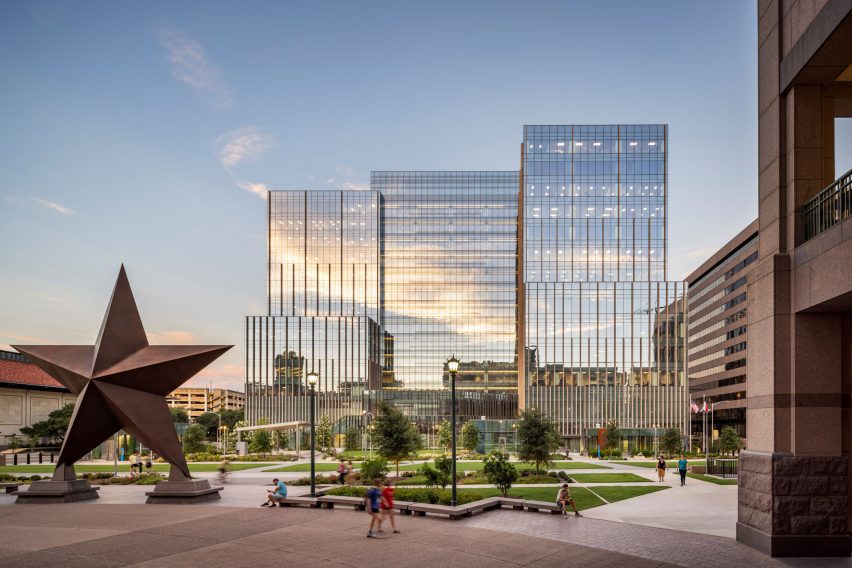
"The project aligns with Austin's larger objectives of sustainable urban development, economic growth, and community engagement, including reimagining the 40-block area surrounding the Capitol building," the team said.
"It improves the built environment of the city and offers useful amenities that allow the public and state agencies to interact in a shared area located in the heart of Austin."
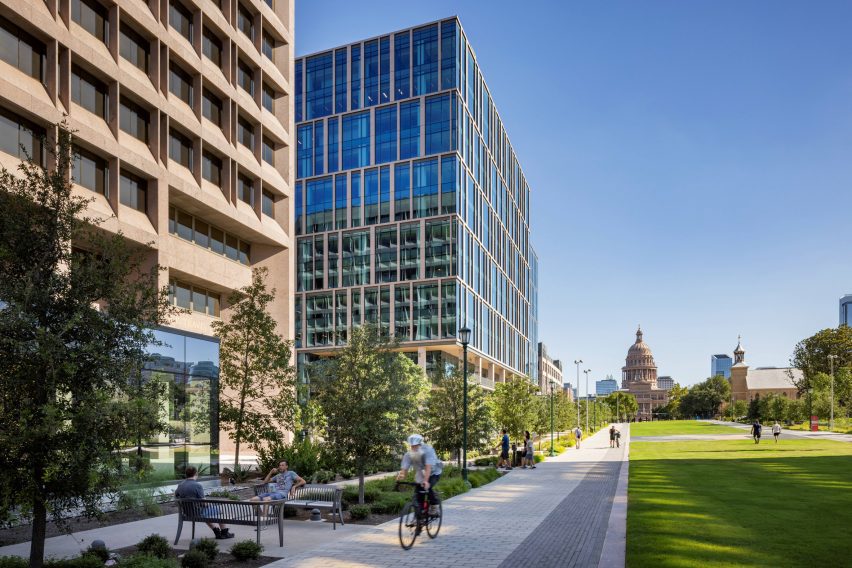
The team also incorporated a vibrant Capitol Mall that "serves as a gathering space and a bridge between Austin's historical districts and modern developments, centering the State Capitol as the focal point of the visitor experience," the team said.
Pedestrian pathways provide connections and embedded plazas to landmarks like the Texas History Museum and the University of Texas at Austin Blanton Art Museum, stitching together an easily navigable urban fabric for visitors and "fostering unity between Austin's past and present and enriching the city's cultural landscape."
The connections provide a way for the city's development to recognize the past, while leaving space for future expansion.
Meanwhile, the network encourages non-vehicular connection from the university to the capitol grounds. When combined with the UT Austin Speedway Mall, the urban plan includes a 15-block pedestrian corridor with only two significant vehicular cross streets.
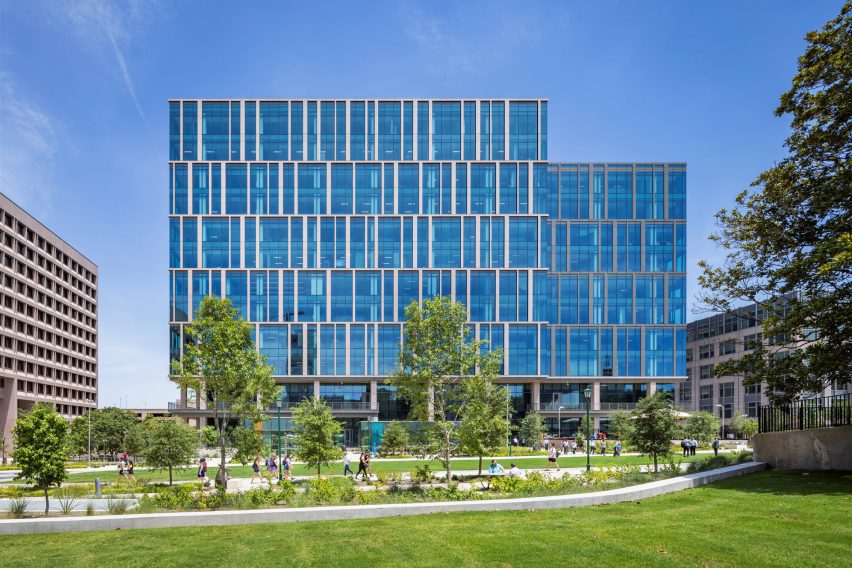
Currently under construction, Phase 2 utilizes Page's master plans with final architectural designs by HOK. The map denotes near-term developments in orange and long-term developments in the lighter peach shade.
It includes two more office buildings – an eight-storey structure measuring 360,000 square feet (33,445 square metres) and a five-storey structure measuring 165,000 square feet (15,329 square metres) – as well as an extension to the Texas Capitol Mall and parking infrastructure.
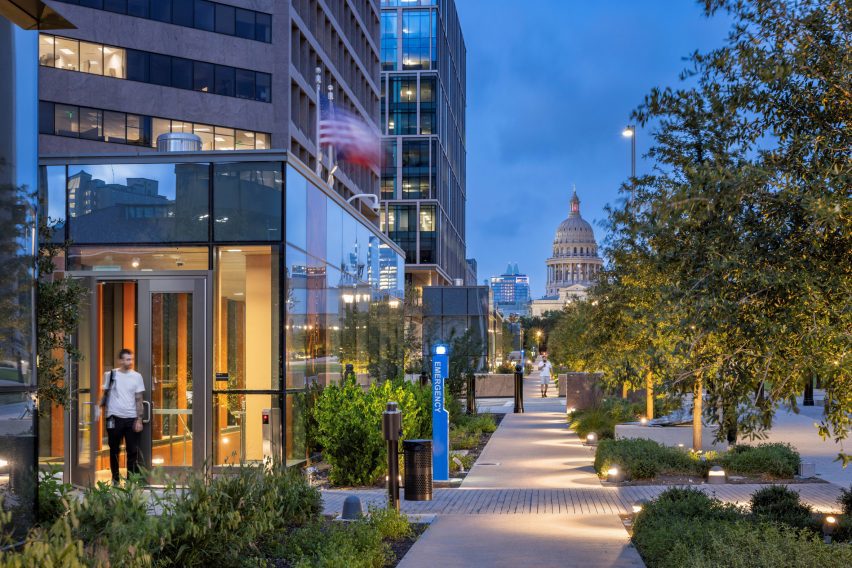
Sunset red granite and glazed curtain walls will comprise the office buildings in Phase 2, which is slated to open at the end of 2026.
Phase 3 is projected to add another two buildings totalling 500,000 square feet (46,451 square metres).
Phases 2 and 3 will tie in and celebrate the Historic Garden District, creating a smaller, more humble counterpoint to the adjacent Mall.
"The project's focus on sustainability and historic preservation shows Austin's dedication to protecting the environment and respecting its rich cultural legacy," Page said. "Overall, the space is a significant driver for urban revitalization, fostering a dynamic and interconnected cityscape embodying Austin's spirit of innovation and inclusivity."
Other projects currently under construction in Austin include Gensler's trapezoidal skyscraper known as Sixth and Guadalupe, which is expected to be complete in Summer 2024, and Kohn Pedersen Fox's Waterline tower, set to be Texas' tallest building when it is complete.
The photography is by Albert Vecerka/Esto.
Project credits:
Planning/Urban Design:
Page (TCCMP)
Architect: Master Architect/Engineer: Page, AOR for George HW Bush Building: HKS, Inc., AOR for Barbara Jordan Building: Kirksey AOR for Capitol Mall: Kirksey, EOR for Central Utility Plant: Jacobs
Client: Texas Facilities Commission
Landscape architect:
Sasaki (Master A/E Team), Coleman Assoc. (AOR team)
General contractor: CM Agent: Balfour Beatty, CMR for George HW Bush Building: Flintco, CMR for Barbara Jordan Building: White Construction, CMR for Capitol Mall: White Construction, CMR for Central Utility Plant: JE Dunn
Structural engineer: Ensight Haynes Whaley (Master AE Team), Martinez Moore (EOR for George HW Bush Building), Ensight Haynes Whaley (EOR for Barbara Jordan Building), Ensight Haynes Whaley (EOR for Capitol Mall), Encotech (EOR for Central Utility Plant)
Civil engineer: Page (TCCMP), Cobb Fendley (Site Utilities Engineer and TCCMP 2020 Update), MWM Design Group (TCCMP 2020 Update)
Garza EMC (Master AE Team), Garza EMC (George HW Bush Building), Jones & Carter (Barbara Jordan Building) Jones & Carter (Capitol Mall)
Garza EMC (Central Utility Plant)
MEP Engineer:Page (Mech. & Elec. Master AE Team), CNG (Plumbing Master AE Team), Jose I. Guerra, Inc. (TCCMP), HDR (TCCMP 2018 Update and Master AE Team), HMG (George HW Bush Building), Wylie (Barbara Jordan Building), Wylie (Capitol Mall), Jacobs (Central Utility Plant)
Rendering / visualization studio: Page with Bogza Studio (Master AE Team)
Sustainability consultant:
Page (TCCMP and Master AE Team), Bee (Energy Modeling)
Interior design:
Page (Master AE Team), Bommarito (Master AE Team), HKS Inc., Studio 8 (AOR team for George HW Bush Building), Kirksey (AOR Team for Barbara Jordan Building)
Facade consultant: Page (Master AE), WJE (Master AE Team)
Parking and transportation:DeShazo Group (TCCMP), Alliance Transportation (TCCMP 2020 Update), HWA Parking
Graphic design & wayfinding: Page (TCCMP and Master AE)
Lighting designer: HLB (Master AE Team)
Market analysis: HR&A Advisors
Planning support: Sasaki (TCCMP)
Acoustics consultant / Engineer: JEA (Master AE Team)
Cost estimating: Sunland Group (TCCMP)
Planting consultant: Lady Bird Johnson Wildflower Center (TCCMP 2018 Update)
Manufacturers: Coldspring (Texas Sunset Red Granite), Win-con (Curtain Wall – George HW Bush Building), Admiral Glass (Curtain Wall – Barbara Jordan Building), Clean Scapes (Landscaping - Capitol Mall)